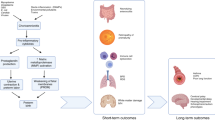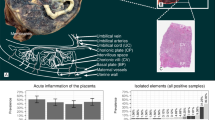Abstract
Objective:
To estimate the association between chorioamnionitis, maternal risk factors and birth outcomes.
Study Design:
A cross-sectional study of 600 pregnant women was conducted at a maternity center in Dhaka from January to October 2011. Outcomes included histologic, microbiologic and clinical chorioamnionitis. Log-binomial models assessed the association between risk factors and histologic chorioamnionitis (HC).
Results:
Of the 552 women with placental specimens, 70 (12.7%) were classified with HC: 46 (65.7%) with and 24 (34.3%) without fetal involvement. HC was associated with non-physician care (relative risk [RR] 2.04, 95% confidence interval [CI] 1.04 to 4.00), home slab or hanging latrine (RR 1.69, 95% CI 1.10 to 2.62), and lack of tetanus toxoid (RR 1.80, 95% CI 1.03 to 3.14). Women with fever (RR 2.30, 95% CI 1.18 to 4.50) or discolored amniotic fluid (RR 1.74, 95% CI 1.08 to 2.81) had a higher risk of HC. Microbiologic and clinical chorioamnionitis were unreliable HC measures.
Conclusion:
Prevalence of HC is high; many cases are not captured by clinical diagnosis or microbiologic cultures.
This is a preview of subscription content, access via your institution
Access options
Subscribe to this journal
Receive 12 print issues and online access
$259.00 per year
only $21.58 per issue
Buy this article
- Purchase on Springer Link
- Instant access to full article PDF
Prices may be subject to local taxes which are calculated during checkout
Similar content being viewed by others
References
Tita AT, Andrews WW . Diagnosis and management of clinical chorioamnionitis. Clin Perinatol 2010; 37 (2): 339–354.
Benitz WE, Gould JB, Druzin ML . Risk factors for early-onset group B streptococcal sepsis: estimation of odds ratios by critical literature review. Pediatrics 1999; 103 (6): e77.
Chan GJ, Baqui AH, Modak JK, Murillo-Chaves A, Mahmud AA, Boyd TK et al. Early-onset neonatal sepsis in Dhaka, Bangladesh: risk associated with maternal bacterial colonisation and chorioamnionitis. Trop Med Int Health 2013; 18 (9): 1057–1064.
de Araujo MC, Schultz R, Vaz FA, Massad E, Feferbaum R, Ramos JL . A case-control study of histological chorioamnionitis and neonatal infection. Early Hum Dev 1994; 40 (1): 51–58.
Newton ER . Chorioamnionitis and intraamniotic infection. Clin Obstet Gynecol 1993; 36 (4): 795–808.
Goldenberg RL, Hauth JC, Andrews WW . Intrauterine Infection and preterm delivery. N Engl J Med 2000; 342 (20): 1500–1507.
Luck S, Torny M, d'Agapeyeff K, Pitt A, Heath P, Breathnach A et al. Estimated early-onset group B streptococcal neonatal disease. Lancet 2003; 361 (9373): 1953–1954.
Sebire NJ, Goldin RD, Regan L . Histological chorioamnionitis in relation to clinical presentation at 14-40 weeks of gestation. J Obstet Gynaecol 2001; 21 (3): 242–245.
Zanardo V, Vedovato S, Cosmi E, Litta P, Cavallin F, Trevisanuto D et al. Preterm premature rupture of membranes, chorioamnion inflammatory scores and neonatal respiratory outcome. BJOG 2010; 117 (1): 94–98.
Seale AC, Mwaniki M, Newton CR, Berkley JA . Maternal and early onset neonatal bacterial sepsis: burden and strategies for prevention in sub-Saharan Africa. Lancet Infect Dis 2009; 9 (7): 428–438.
Gravett CA, Gravett MG, Martin ET, Bernson JD, Khan S, Boyle DS et al. Serious and life-threatening pregnancy-related infections: opportunities to reduce the global burden. PLoS Med 2012; 9 (10): e1001324.
National Institute of Population Research and Training (NIPORT), Mitra and Associates, and ICF International. Bangladesh Demographic and Health Survey 2011. Dhaka, Bangladesh and Calverton, Maryland, USA: NIPORT, Mitra and Associates, and ICF International. 2013..
UNICEF and the World Health Organization Caring for the Newborn at Home: A Training Course for Community Health Workers. World Health Organization: : Geneva, Switzerland, 2012.
Vyas S, Kumaranayake L . Constructing socio-economic status indices: how to use principal components analysis. Health Policy Plan 2006; 21 (6): 459–468.
Rothman KJ . No adjustments are needed for multiple comparisons. Epidemiology 1990; 1 (1): 43–46.
American Congress of Obstetricians and Gynecologists. Chorioamnionitis: Diagnosis and Treatment. Available at: http://www.acog.org/~/media/Districts/District%20VIII/AntibioticTreatmentChorioamnionitis.pdf?dmc=1. (accessed on 1 May 2015).
Holzman C, Lin X, Senagore P, Chung H . Histologic chorioamnionitis and preterm delivery. Am J Epidemiol 2007; 166 (7): 786–794.
Roescher AM, Timmer A, Erwich JJ, Bos AF . Placental pathology, perinatal death, neonatal outcome, and neurological development: a systematic review. PLoS One 2014; 9 (2): e89419.
Kim CJ, Romero R, Chaemsaithong P, Chaiyasit N, Yoon BH, Kim YM . Acute chorioamnionitis and funisitis: definition, pathologic features, and clinical significance. Am J Obstet Gynecol 2015; 213 (4 Suppl): S29–S52.
Tolockiene E, Morsing E, Holst E, Herbst A, Ljungh A, Svenningsen N et al. Intrauterine infection may be a major cause of stillbirth in Sweden. Acta Obstet Gynecol Scand 2001; 80 (6): 511–518.
Folgosa E, Gonzalez C, Osman NB, Hagerstrand I, Bergstrom S, Ljungh A . A case control study of chorioamniotic infection and histological chorioamnionitis in stillbirth. APMIS 1997; 105 (4): 329–336.
Roberts DJ, Celi AC, Riley LE, Onderdonk AB, Boyd TK, Johnson LC et al. Acute histologic chorioamnionitis at term: nearly always noninfectious. PLoS One 2012; 7 (3): e31819.
Goldenberg RL, McClure EM, Belizan JM . Commentary: reducing the world's stillbirths. BMC Pregnancy Childbirth 2009; 9 (Suppl 1): S1.
Thaver D, Zaidi AK . Burden of neonatal infections in developing countries: a review of evidence from community-based studies. Pediatr Infect Dis J 2009; 28 (1 Suppl): S3–S9.
Schrag SJ, Zywicki S, Farley MM, Reingold AL, Harrison LH, Lefkowitz LB et al. Group B streptococcal disease in the era of intrapartum antibiotic prophylaxis. N Engl J Med 2000; 342 (1): 15–20.
Acknowledgements
We acknowledge financial support by the Thrasher Research Fund Early Career Award and a grant from the National Center for Research Resources (5KL2RR025006), a component of the National Institutes of Health (NIH) and the NIH Roadmap for Medical Research.
Author information
Authors and Affiliations
Corresponding author
Ethics declarations
Competing interests
The authors declare no conflict of interest.
Rights and permissions
About this article
Cite this article
Chan, G., Silverman, M., Zaman, M. et al. Prevalence and risk factors of chorioamnionitis in Dhaka, Bangladesh. J Perinatol 36, 1039–1044 (2016). https://doi.org/10.1038/jp.2016.150
Received:
Revised:
Accepted:
Published:
Issue Date:
DOI: https://doi.org/10.1038/jp.2016.150
This article is cited by
-
Biomarkers for a histological chorioamnionitis diagnosis in pregnant women with or without group B streptococcus infection: a case-control study
BMC Pregnancy and Childbirth (2021)



